Click image for BBB rating
See our Privacy Policy
Welcome to Spaightwood Galleries, Inc.
120 Main Street, Upton MA 01568-6193
You can follow us on Facebook and Twitter!
We blog regularly on Facebook and announce special events and special sales on both sites.
Last updated: 7/21/2017
Gérard Titus-Carmel (French, b. 1942): Le Casque de Nikko (1983)
Gérard Titus-Carmel is an artist of the same generation as my wife and I. Born in 1942, he, like the others of our time, grew up in an international world, a world where national boundaries exist as memories of a world we can no longer afford, a world of national interests, rivalries, wars. Born during the second world war, we know it only through the nightmares of our parents, the memories of our elders. We are the children of the bomb, survivors of grade school civil-defense exercises in case of nuclear attack, the adolescents of the nervous and electric rhythms of hard-bop, voyagers with musicians like Thelonious Monk and Sonny Rollins, Eric Dolphy (with whom Titus, a drummer, played, for one set, once) and John Coltrane, explorers of the musical unknown. We have listened to the same music, read the same books, visited many of the same places, looked at much of the same art. Living in the same world, and trying to come to terms with the things that shaped it, we came of age during the Cuban Missile crisis with its threat of a holocaust greater than any that haunts the dreams of our parents' generation. We have lived almost our entire lives in a world held in uneasy peace only by the threat of "Mutual Assured Destruction." Yet we have also walked in the ruins of Monte Alban and stood in the ball court of the Olmecs; we have listened to ancient mariners as the surf laps the shores bordering the oceans of our dreams. For our generation, the problem has been one not so much of finding reality, but of finding a reality that will permit us to live not just within our world but within ourselves as well. For that effort, we need more than the "superrealism" or the theatrical "neo-expressionism" of the '80s, more than an art that commercially derides "the system" for being too commercial; we need an art that can take us beyond the surfaces, that remembers its past and our past, that can teach us what to remember and how to forget what we do not need to remember to go on with life.
Titus-Carmel’s work is simultaneously utterly fascinating and just a bit disturbing: to be forced to see these ‘made-up objects‘ with such intensity and so convincingly present is to forget Magritte's injunction (‘Ceci n'est pas un pipe’; it was, of course, not a pipe, but a painting of a pipe, a representation, or, if you will, a re-presentation of a pipe, a common object as seen by the artist and shown by him to us)—these are "Tlingit Coffins," "Narwa objects," etc, but, then again, what are they, these imaginary objects shown with utter fidelity to the ‘real' models Titus-Carmel often makes before he begins his drawings and etchings? What indeed are they, these objects Titus-Carmel sees and how are we to seee them? In the five mixed media prints (combining etching, aquatint, and drypoint) we see in each at the top of the sheet printed in a color different than the much larger detail below a cloth (a sail?) wrapped around a large stick to which it is tied at the top; at the bottom of the sheet, suspended from the top, is another large stick hangin from cloth ties from the upper stick. Below it we see a much larger detail of this small composition printed in a different color ink. Upon closer examination and re-examinationm, it becomes clear—mostly, sort of, maybe—that none of the details correspond exactly to their section of the small depiction of the whole above.
Japanese culture is very importnat to Titus-Carmel. He met his wife Joan Robinson Titus-Carmel when he was visiting for an exhibition and she was on vacation from her teaching job in a Japanese school (she is fluent in Japanese and had a best-selling volume of translations of Japanese Haiku into French a number of years ago. Le Casque de Nikko / The Nikko Helmet began when Titus saw and purchased a child-sized Japanese Samurai Helmet (a photograph of it can be seen on page 11 of Gérard Titus-Carmel: Rétrospective de lo'oeuvre gravé 1965-1991, the catalogue raisonné of his prints published by the Machida City Museum of Tokyo on the occasion of a retrospective of his prints in 1991; see below for details).
Titus-Carmel is one of the most written-about contemporary French artists, having been the subject of studies by Jacques Derrida, Alain Robbe-Grillet, Gilbert Lascault, Werner Spies, Jean Pierre Faye, Denis Roche, Jean Louis Schefer, and many others. He is also one of the most widely shown artists of his generation (b. 1942), having received over 400 group ahows and over150 one–person shows at museums and galleries including The Museum of Modern Art of the City of Paris (1971), the 1972 and 1984 Venice Biennales, the Royal College of Art in London (1972), the Stedelijk Museum in Amsterdam (1973), the Palais des Beaux Arts, Brussels (1975), the Centre Georges Pompidou / Musée National d'Art Moderne (1978), the Museums of Dusseldorf (1979), Bielefeld (1980), Kassel (1980), Nuremberg (1981), Oslo (1981), Lubceck (1981), Les Sables d'Olonne (1981), Luxemburg, Calais, (1984), Nice, Carcassonne, and Lille (1985), Quebec (1986), Budapest, and Châteauroux (1987), Caen (1989), Montaubon and Avignon (1990), and Tokyo (1991). In addition, the French Cultural Ministry also organized touring exhibits at the Instituts Français of Stuttgart, Hamburg, Munich, and Bonn (1985), Damascus, Aleppo, Alexandria, Cairo (1990-1991), and Palermo, Naples, and Rome (1991). His works are in the permanent collections of over 100 public institutions including the Guggenheim Museum (New York), the Museum of Modern Art (N.Y. and Paris), the Chicago Art Institute, the Bibliotheque National and the Centre Georges Pompidou (Paris), the Victoria and Albert Museum (London), and many others. He has also participated as the official delegate for France in numerous international exhibitions, such as the Biennial of Paris (Paris, 1969), Expo ’70 (Osaka, 1970), the Biennial of Alexandria (Alexandria, 1971), “Amsterdam-Paris-Düsseldorf ” (Guggenheim Museum, New York, 1972), Dokumenta VI (Kassel, 1977), “European Dialogue” (the Sidney Biennial, 1979), “Statements/Leading Contemporary Artists from France”(New York, Dallas, San Francisco, Seattle, 1982), Biennale Internazionale Arte (Venice, 1972 and 1984), “Gerard Titus-Carmel: Forging the Real” (Spaightwood Galleries, 1988), Art in France: a Century of inventions (Moskva , Leningrad, 1989), “Contemporary Art in France” (French Pavillion, Universal exposition, Sevilla, 1992), Fonds regional d’art contemporain de Picardie (1993), the Instituts Français of Casablanca, Rabat, Tangier, and Tetuan (1995), Musée de l’Hospice Saint-Roch, Issoudun (1997), Soissons (1998), Titus-Carmel: Une decennie (a large-format hardcover published by Editions Palantines, 2000 to accompany a touring show that went to 5 French museums documented many of the series of the preceding 10 years), another large-format work, Gérard Titus-Carmel: La parte du livre (Reims: Bernard Dumerchez éditeur, 1995) documented Titus’ involvement with books (whether as writer, illustrator, or subject), François-Marie Deyrolle, ed. La Geste & la Mémoire: Regardes sur la peinture de Gérard Titus-Carmel (Ain: L’Act Mem, 2007) contained 28 brief essays collected from prefaces to various exhibition catalogs between 1973 and 2006) by a wide range of poets, novelists, and art critics among others. In 2007, Michael Bishop’s The Endless Theory of Days: The Art and Poetry of Gérard Titus-Carmel (NY: Rodopi, 2007), the first full-length study of Titus as artist and poet in English. Last, but hardly least, in 1987, the University of Chicago Press published Jacques Derrida, The Truth in Painting, trans. Geoff Bennington and Ian MacLeod, chapter 3 of which contains an English translation of Cartouches, the essay that Derrida wrote in 1978 to introduce the installation of Titus’ exhibition of The Pocket Size Tlingit Coffin, a collection of 127 mixed-media drawings on an imaginary object that Titus invented, manufactured, and drew over the course of a year and which the Musée national d’art moderne at the Centre Pompidou purchased in its entirety.
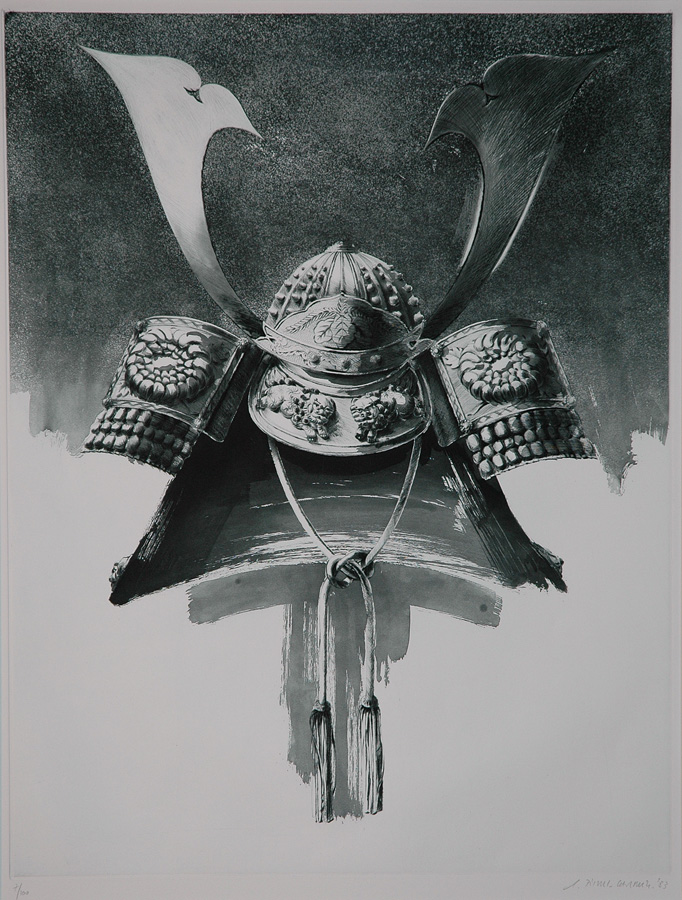
Le Casque de Nikko I / The Nikko Helmet I (Machida 131). Original drypoint and aquatint in Prussian blue printed by Piero Crommelynck and published by Maeght Lelong, 1983. 100 signed and numbered impressions, 10 artist's proofs, and 6 HC impressions on BFK Rives paper. Image size: 645x497mm; Paper size: 905x679mm. Price: Please call or email for current pricing information.
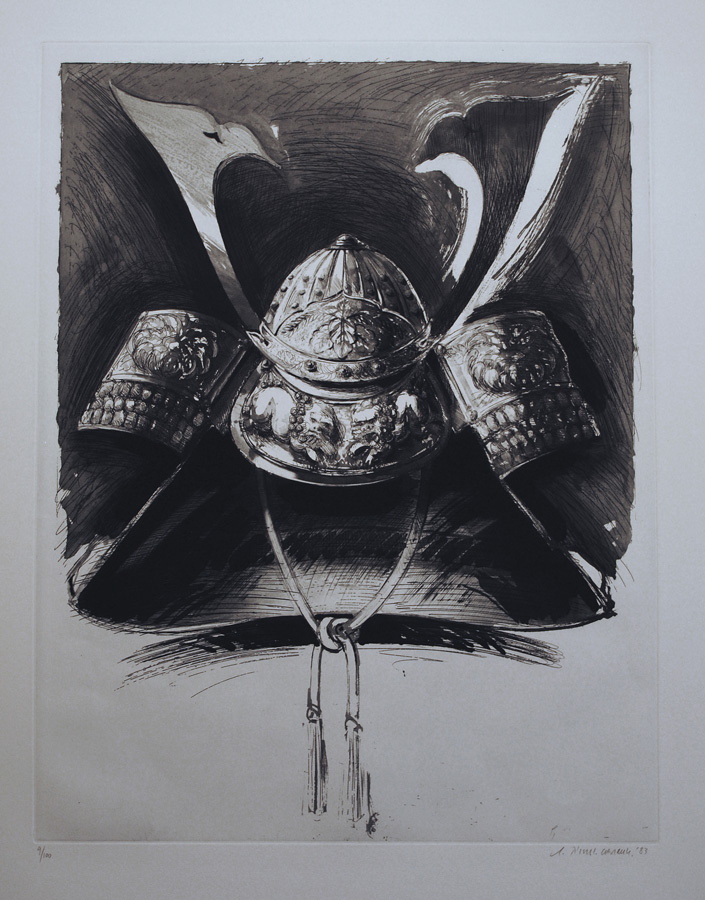
Le Casque de Nikko II / The Nikko Helmet II (Machida 132). Original etching and aquatint in Prussian blue printed by Piero Crommelynck and published by Maeght Lelong, 1983. 100 signed and numbered impressions, 10 artist's proofs, and 6 HC impressions on BFK Rives paper. Image size: 645x497mm; Paper size: 905x679mm. Price: Please call or email for current pricing information.
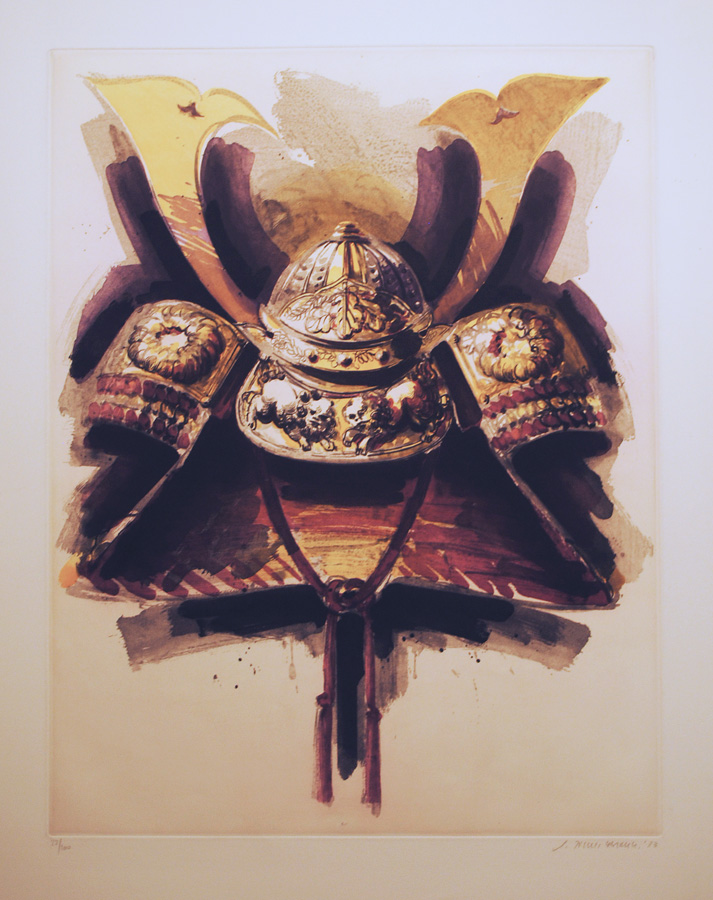
Le Casque de Nikko III / The Nikko Helmet III(Machida 133). Original etching and aquatint printed in 4 colors from 2 copper plates by Piero Crommelynck and published by Maeght Lelong, 1983. 100 signed and numbered impressions, 10 artist's proofs, and 6 HC impressions on BFK Rives paper. Image size: 645x497mm; Paper size: 905x679mm. Price: Please call or email for current pricing information.
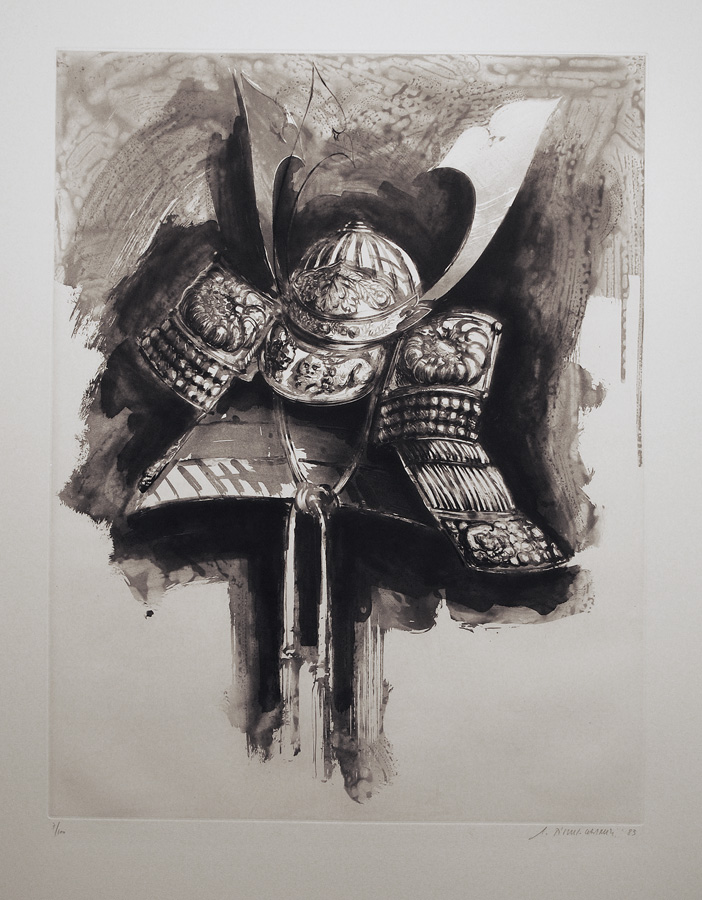
Le Casque de Nikko IV / The Nikko Helmet IV (Machida 134). Original etching, drypoint, and aquatint printed in noir bistré from one copper plates Piero Crommelynck and published by Maeght Lelong, 1983. 100 signed and numbered impressions, 10 artist's proofs, and 6 HC impressions on BFK Rives paper. Image size: 645x497mm; Paper size: 905x679mm. Price: Please call or email for current pricing information.
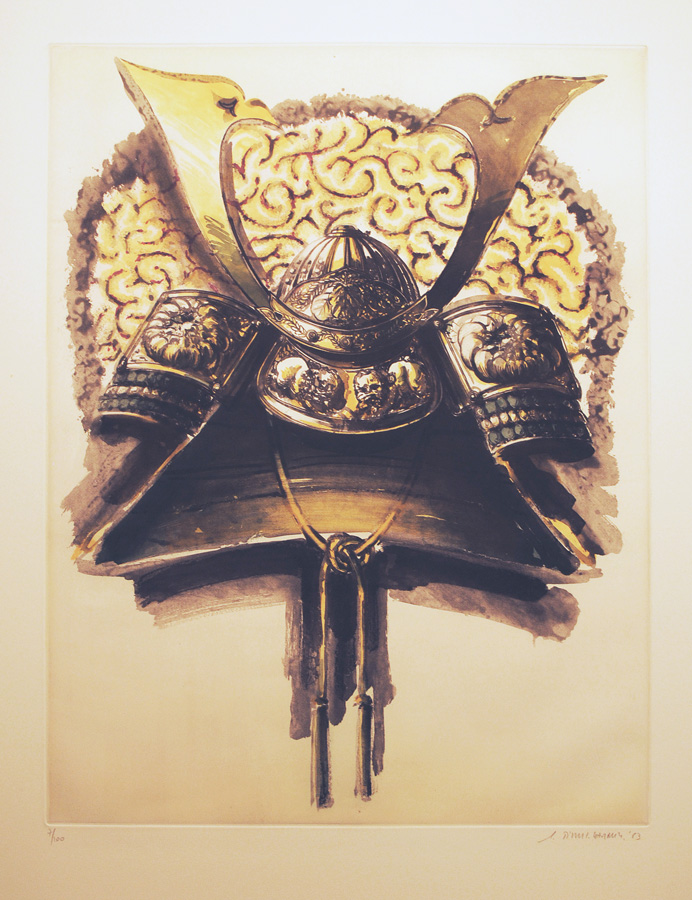
Le Casque de Nikko V / The Nikko Helmet V (Machida 133). Original etching and aquatint printed in 4 colors from 2 copper plates by Piero Crommelynck and published by Maeght Lelong, 1983. 100 signed and numbered impressions, 10 artist's proofs, and 6 HC impressions on BFK Rives paper. The first four works in this small series (augmented by a substantial number of drawings of various sizes, ranging from the small to the monumental) simply deepict the Nikko helmet as seen from various perspectives; the last one, with the helmet sitting in front of what looks like a skull packed with brains, suggests the more serious function of a warrior's helmet: to prevent, as much as is possible, the wearer's brains from being splattered all over the scene. Image size: 645x497mm; Paper size: 905x679mm. Price: Please call or email for current pricing information.
Spaightwood Galleries owns almost every print Titus-Carmel has made since 1975 (and a few before that), 7 paintings, 4 collages, 7 watercolors, and 8 drawings. If you are interested in a piece we have not yet illustrated on our web-site, please call or e-mail us. In 1992 Spaightwood published Gérard Titus-Carmel: Forging the Real. With 43 illustrations, an insightful essay, a list of one-person exhibitions, and a full but selective bibliography of writings about Titus-Carmel, it’s the best available introduction to his work (up to 1992) in English. Available for only Please call or email for current pricing information.00 plus shipping via priority mail for Please call or email for current pricing information.20.
We also have copies of the 1992 Catalogue Raisonne of his prints published in Tokyo by the Machida Museum with text in Japanese and French and illustrations of every print Titus had made up until the date of its publication (about 200 works). Three thousand copies were printed, and almost all sold in Tokyo. Rare in Europe and America. Mint copies availabe for Please call or email for current pricing information
We also have copies of the 1992 Catalogue Raisonne of his prints published in Tokyo by the Machida Museum with text in Japanese and French and illustrations of every print Titus had made up until the date of its publication (about 200 works). Three thousand copies were printed, and almost all sold in Tokyo. Rare in Europe and America. Mint copies availabe for Please call or email for current pricing information
Spaightwood Galleries, Inc.
To purchase, call us at 1-800-809-3343 (1-508-529-2511 in Upton MA & vicinity) or send an email to spaightwood@gmail.com.
We accept AmericanExpress, DiscoverCard, MasterCard, and Visa.
We also accept wire transfers and paypal.
For directions and visiting information, please call. We are, of course, always available over the web and by telephone (see above for contact information). Click the following for links to past shows and artists. For a visual tour of the gallery, please click here. For information about Andy Weiner and Sonja Hansard-Weiner, please click here. For a list of special offers currently available, see Specials.
All works are sold with an unconditional guarantee of authenticity (as described in our website listing).
Copyright 2004-2017, Spaightwood Galleries, Inc.
Go back to the top of this page.
Visiting hours: Saturday 10:00 am to 5:00 pm and Sunday noon to 6:00 pm and other times by arrangement.
Please call to confirm your visit. Browsers and guests are welcome.




